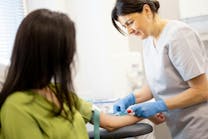Testing asymptomatic healthcare personnel for COVID-19 not recommended
Routine testing of asymptomatic healthcare personnel (HCP) in the absence of confirmed exposures to COVID-19 is not a recommended strategy for preventing transmission of SARS-CoV-2 causing the current global pandemic, according to a new review co-authored by researchers from UNC Medical Center and Massachusetts General Hospital.
The researchers are David Weber, MD, MPH, professor of medicine at the UNC School of Medicine and Medical Director of Infection Prevention at the UNC Medical Center, and Erica S. Shenoy, MD, PhD, associate chief of the Infection Control Unit at Massachusetts General Hospital (MGH)
The review, published in Infection Control & Hospital Epidemiology, found that such testing is unlikely to affect the transmission of SARS-CoV-2 in healthcare settings and could even have unintended negative consequences, according to news releases from both medical centers.
Current public health recommendations are to test individuals with symptoms consistent with COVID-19 and those with confirmed exposures. At some health systems, asymptomatic employees are provided access to testing when it is required (such as for travel), but routine surveillance of healthcare personnel has not been pursued.
Shenoy and Weber compiled data from MGH’s voluntary testing program as well as several other hospitals that had either screened or made COVID-19 testing available to asymptomatic healthcare personnel. Infection rates ranged from 0.2 percent to 0.4 percent (i.e., 1 in 250 to 1 in 500).
MGH’s asymptomatic on-demand testing program continues, and the frequency of positive COVID-19 tests in healthcare personnel prevalence has remained below 1 percent. “This low prevalence means that in a routine surveillance approach, you would have to test a lot of people in order to detect one asymptomatic case.”
Given the low frequency of positive tests, the possibility of false positive results is a concern, and Shenoy and Weber describe how facilities considering routine surveillance must consider whether confirmatory testing would be used to address the possibility of false-positive results.
The literature suggests that the risk of healthcare personnel and patients transmitting the coronavirus to one another is very low when effective safety protocols such as wearing masks, testing when indicated, and screening symptomatic patients are followed. Reported instances of healthcare personnel acquiring infection through exposures to patients show overall low risk of transmission. Similarly, risk to patients from asymptomatic infected healthcare providers has also been reported to be low, highlighting the efficacy of current protocols, Shenoy and Weber found.
Instead of considering routine screening of healthcare personnel for COVID-19, hospitals should continue to focus on interventions that are known to reduce spread of the disease, which also include rapid identification and isolation of patients who are suspected of COVID-19, proper use of personal protective equipment when appropriate, and testing asymptomatic patients known to have been exposed to the coronavirus, the researchers advised.




